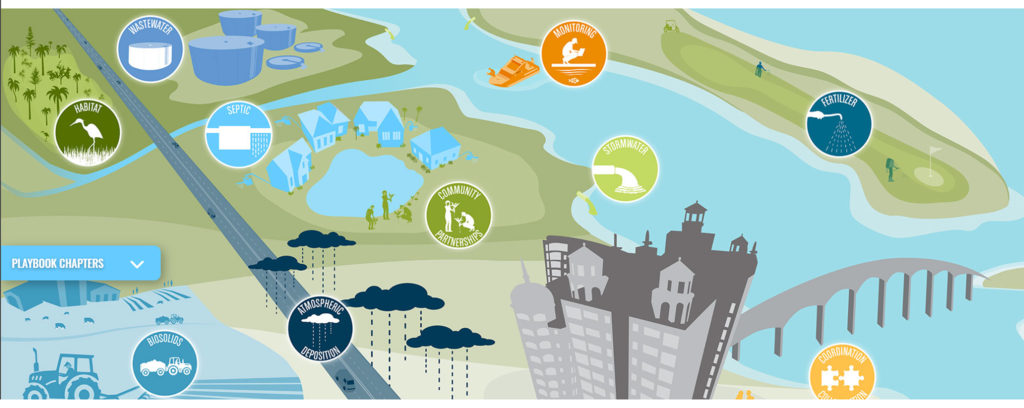
Education
Education Matters | The Water Quality Playbook: Gulf Coast Community Foundation’s Transformational Environment Plan
By Ryan G. Van Cleave | April 2022
The environmental message has been constant and clear—as much as we might wish it were otherwise, we’re doing real harm to the planet. We’ve been doing this for a long time, notes Jon Thaxton, Gulf Coast Community Foundation’s Senior Vice President for Community Leadership. “I’m a fifth-generation Floridan who was raised on a farm near Osprey,” he says. As far back as the 1960s, he remembers “crusty old fishermen” complaining about poor water quality and their inability to make a living because of red tide. They blamed the water issues on the endless creation of shopping malls and subdivisions. Decades later, they’ve been proven to be correct.

“We’ve taken a landscape that was designed for a particular pulse of water of a particular quality at a particular time of the year to come from the sky, to the land, and into the banks—a beautiful system that’s perfectly balanced,” Thaxton explains. “Then we came in and totally screwed the whole thing up. If you were to write a plan to destroy Sarasota Bay, you probably couldn’t have written a better script than what we’ve done in Southwest Florida, where we took the land that was hypersensitive to change and we developed it at a time when there were virtually no regulations. Now, rather than trickling into our bays and estuaries over months and months and months, this pulse of water gets endlessly flushed into the bay.”
Even worse, the water being dumped into the bay is full of nutrients which in small quantities might be good, but at the enormous levels they are, it’s incredibly damaging. It’s carrying nitrogen that’s an ordinary byproduct of our daily lives. It’s hard to think about how something that’s generally considered good or positive can be harmful, but think of it this way—eating chocolate or taking two aspirin a day is okay, but eating three pounds of chocolate or popping forty aspirin a day? That’s not a safe plan. Yet we’re doing the equivalent to our entire water system, only at a far greater level than this.
And Thaxton isn’t standing for it.
From the start, Thaxton has been an environmental activist. He was a founding member of the Ecology Club at Venice High School in 1974, and his efforts to protect endangered species got him featured in National Geographic in 1996. Some years ago, the former three-term Sarasota County Commissioner who is widely known for his conservation work, set his sights on doing something about this devastatingly important water quality situation.
To a group of his environmentalist peers, Thaxton said, “We can spend a lot of time trying to educate 172,600 households in Sarasota County, and then have to re-educate them every three or four years, or we can target the decision makers, the policymakers, and the people charged with permit compliance. We can do so with an interactive, electronic, or web-based platform so that when the science changes, or when improvements are made, we can update it. And if we design it correctly, it can have specific application to Sarasota County, while at the same time being scalable and transferable to other counties in our region and other places in the country.”

With the help of Gulf Coast Community Foundation and a committee made up of regional experts and key industry leaders, that’s exactly what happened. They facilitated, researched, and wrote the Playbook for Healthy Waterways—a.k.a. the Playbook—which is a unique resource to generate and inform community-wide action to transform environmental water quality throughout the region. The target audience includes leaders from all levels of government as well as nonprofit environmental organizations, businesses, homeowner associations, and the agriculture industry.

Dr. Dave Tomasko, Executive Director of the Sarasota Bay Estuary Program, confirms that the level of detail in the Playbook is outstanding. Most resource management guidance for agencies or for the public is so general that it’s not especially actionable because everything seems “important,” he says. “Typically, such reports talk about ‘reduce pollution,’ for example. Fine, but how? What is the most cost-effective thing to do—septic tanks? Upgrading to higher treatment levels at wastewater treatment plants? Stormwater retrofits?” asks Dr. Tomasko. “The Playbook is incredibly detailed guidance. It’s important to note, however, that it only covers half of our watershed—it’s for Sarasota County. It’s relevant for the entire watershed, but there are details about Manatee County that require us to add on to what the Playbook contains.”
That’s easily done, however, because the Playbook is a living document—it’s designed to be updatable. The 43 proposed activities within it can also be customized to fit the needs and challenges of other communities in Florida or beyond. The topics within the Playbook range from wastewater solutions to stormwater system management to wetlands restoration. One of the key issues, though, is how to effectively manage nutrient pollution. The excess nitrogen pollution which has been entering our waterways for generations is pushing the ecosystem to the brink.
One thing we can do right now, explains Thaxton, is to replicate what wetlands used to do. That can happen by keeping fertilizer from entering bodies of water. “If we create a 15-foot no-mow zone on the shores of ponds and lakes, and we let the vegetation grow to a height of a couple of feet, we can eliminate the vast majority of the nutrients being transmitted from suburban landscapes. That’s something half the people in Sarasota County can participate in right now. We’re also finding it saves homeowners associations money because they don’t have to get their muck from the ponds removed.”
Dr. Tomasko is pleasantly surprised by the level of enthusiasm for doing what needs to be done. “Our local governments have publicly committed to spending about $600 million over the next 5 to 10 years on upgrades to wastewater treatment plants and stormwater retrofits to help restore the water quality and ecosystem health of our bay. They’re not waiting for Tallahassee or Washington, D.C. to come to their rescue or to write checks for what is needed (although I’m sure they appreciate all the funding they can get). Not every location is like this, and that’s why I think the future is bright for the restoration of Sarasota Bay.”
Though Thaxton and Dr. Tomasko have a terrific sense of the situation, don’t just take their word for it. Visit the website (www.waterqualityplaybook.org) to see the entire 10-chapter Playbook for yourself.
There’s hope, folks, because we have the play-by-play plan to guide us to a better pathway forward for ourselves and the environment. But having the Playbook only makes a difference if we act on that information. There’s a tipping point just ahead, so the time to act is now.



You must be logged in to post a comment Login